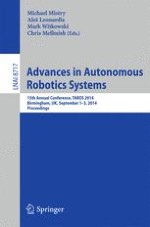2014 | Buch
Advances in Autonomous Robotics Systems
15th Annual Conference, TAROS 2014, Birmingham, UK, September 1-3, 2014. Proceedings
herausgegeben von: Michael Mistry, Aleš Leonardis, Mark Witkowski, Chris Melhuish
Verlag: Springer International Publishing
Buchreihe : Lecture Notes in Computer Science
